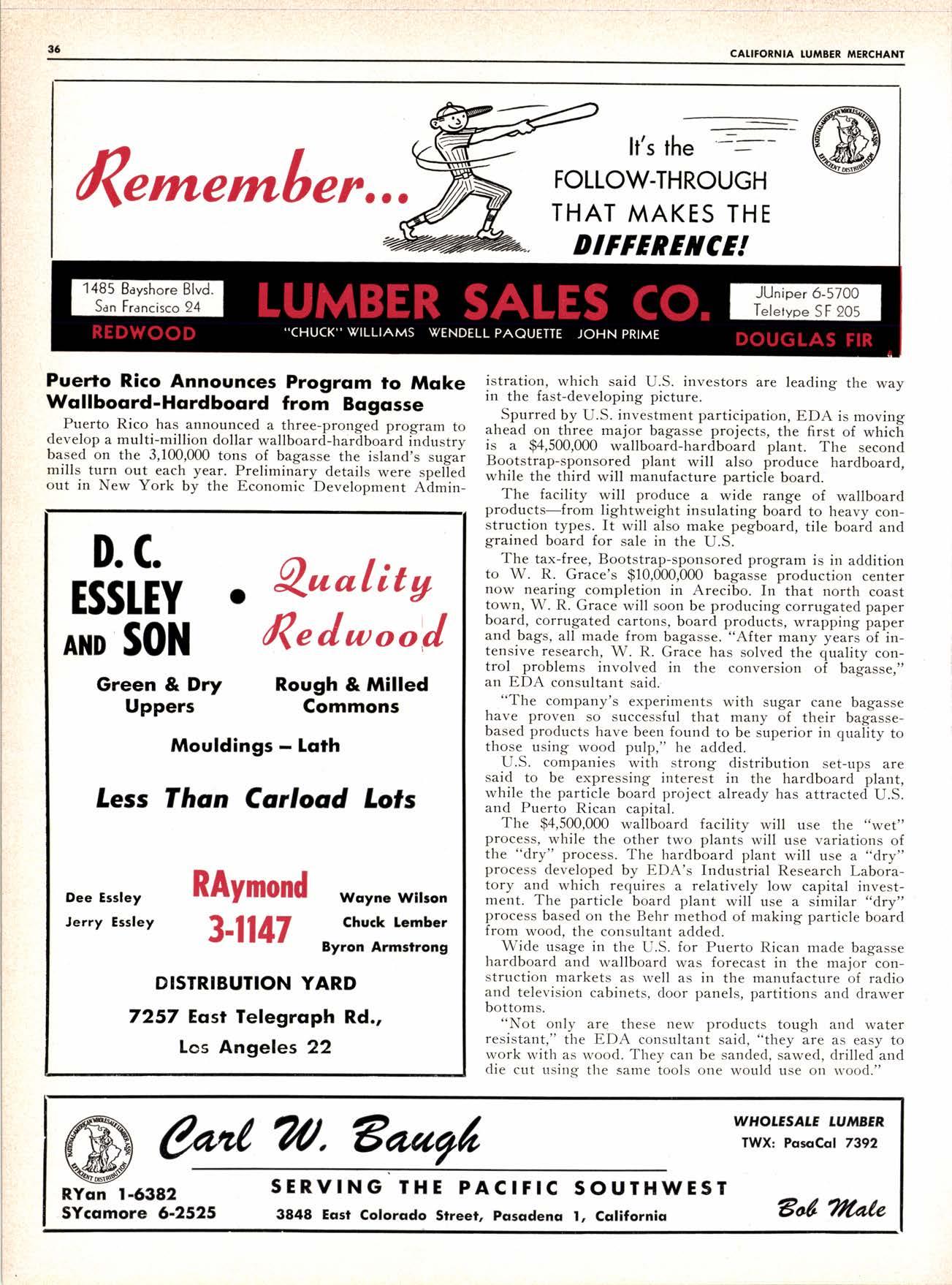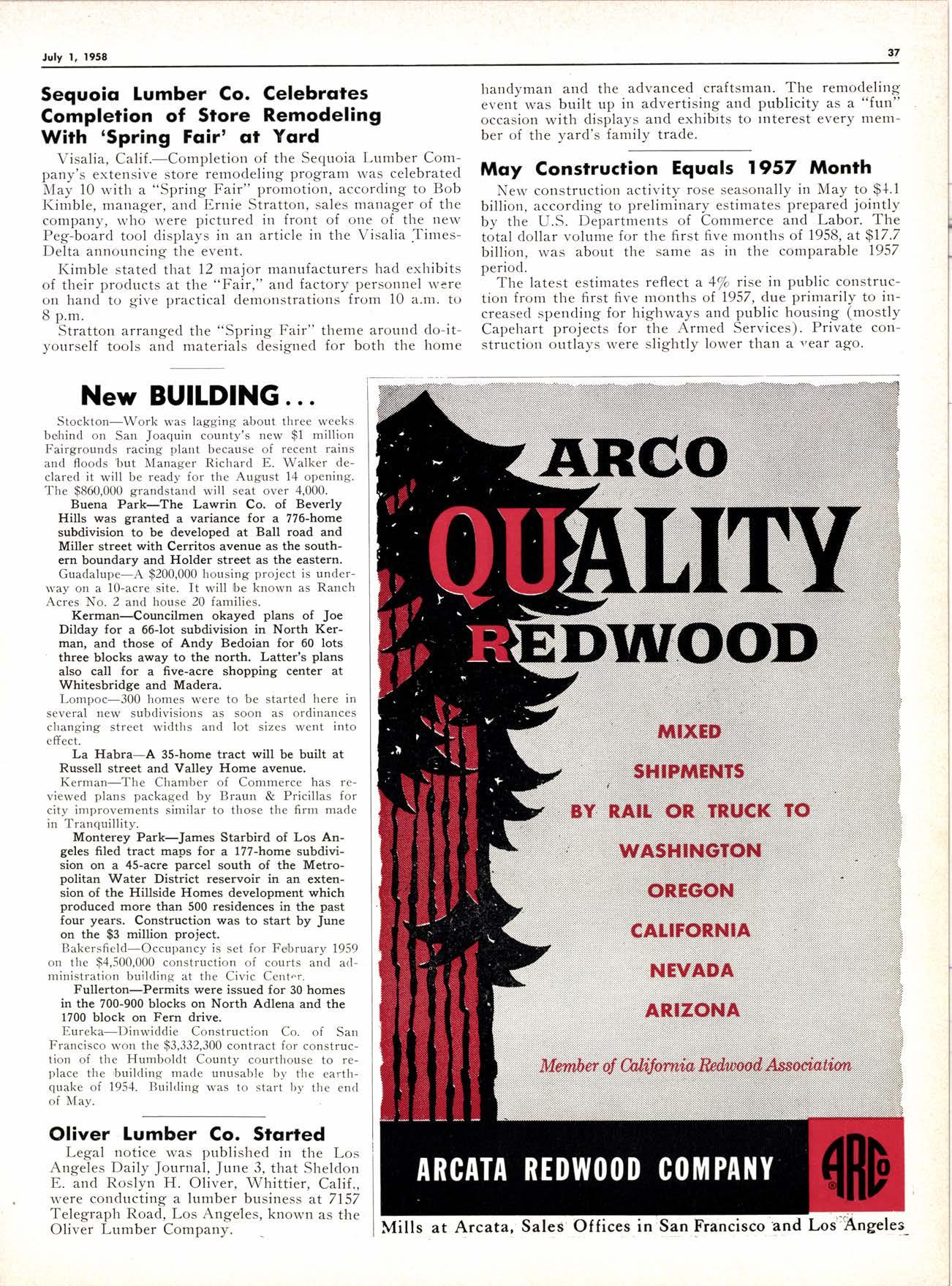
4 minute read
FOLLOW-THROUGH THAT MAKES THE DIFFENEilCE!
JUniper 6-5700
Teletype SF 905
istration, which said U.S. investors are leading the way in the fast-developing picture.
Spurred !y U.S. investment participation, EDA is moving ahead on three major bagasse projects, the first of whicfi is a $4,500,000 wallboard-hardboard plant. The second Bootstrap-sponsored plant will also produce hardboard, while the third will manufaCture particle board.
The facility will produce a wide range of wallboard products-from lightweight insulating boaid to heavy construction types. It will also make pegboard, tile boaid and grained board for sale in the U.S.
The tax-free, Bootstrap-sponsored program is in addition to W. R. Grace's $10,000,000 bagasse production center now nearing completion in Arecibo. In that north coast town, W. R. Grace will soon be producing corrugated paper board, corrugated cartons, board productl, wrap'ping fairer and bags, all made from bagasse. "After many yiari bf intensive research, W. R. Grace has solved the quality con- trol problems involved in the conversion of bagasse," an EDA consultant said.
_ "The company's experiments with sugar cane bagasse have, prov.en so successful that many of their bagassebased products have been found to be superior in quality to those using wood pulp," he added.
U.S. companies with strong distribution set-ups are said to be expressing interest in the hardboard plant, while the particle board project already has attracted U.S. and Puerto Rican capital.
The $4,500,000 wallboard facility will use the "wet" process, while the other two plantj will use variations of the "dry" process. The hardboard plant will use a "dry" process developed by EDA's Industrial Research Laboratory and which requires a relatively low capital investment. The particle board plant will use a similar "d.ry" process based on the Behr method of making particle board from wood, the consultant added.
Wide usage in the U.S. for Puerto Rican made bagasse hardboard and wallboard was forecast in the maior-construction markets as well as in the manufacture -of radio and television cabinets, door panels, partitions and drawer bottoms.
"Not only are these new products tough and water resistant," the EDA consultant said, "they are as easy to work with as wood. Tl-rey can be sanded. sawed. drilled and die cut using tl-re same iools one would use on wood."
Sequoic Lumber Co. Gelebrqtes Completion of Store Remodeling With 'Spring Fcrir' qt Yqrd
Visalia, Calif.-Completion of the Sequoia Lumber Company's extensive store remodeling program was celebrated May 10 with a "Spring Fair" promotion, according to Bob I(imble, manager, and Ernie Stratton, sales manager of the company, who were pictured in front of one of the r-rew Peg-board tool displays in an article in the Visalia TimesDelta announcing the event.
Kimble stated that 12 maior manufacturers had exl-ribits of their products at the "Fair," and factory personnel were on hand to give practical demonstrations from 10 a.m. to 8 p.'''.
Stratton arranged the "Spring Fair" theme around do-ityourself tools and materials designed for both the horne
New BU|LDING...
Stockton-Work was lagging a,bout three weeks behind on San Joaquin county's new $1 million Fairgrounds racing plant because of recent rains and floods 'but Manager Richard E. Walker declared it will be ready for the Augrust 14 opening. The $860,000 grandstand will seat over 4,000.
Buena Park-The Lawrin Co. of Beverly Hills was granted a variance for a 776-home subdivision to be developed at Ball road and Miller street with Cerritos avenue as the southern boundary and Holder street as the eastern.
Guadalupe-A $200,000 housing project is underway on a l0-acre site. It will lbe known as Ranch Acres No. 2 and house 20 families.
Kerman-Councilmen okayed plans of Joe Dilday for a 66-lot subdivision in North Kerman, and those of Andy Bedoian for 60 lots three blocks away to the north. Latter's plans also call for a five-acre shopping center at Whitesbridge and Madera.
Lompoc-300 homes were to tre started here in several new su'bdivisions as soon as ordinances changing street widths and lot sizes went into effect.
La Habra-A 35-home tract will be built at Russell street and Valley Home avenue.
Kerman-The Chamrber of Commerce has reviewed plans packaged by Braun & Pricillas for city improvements similar to those the firm made in Tranquillity.
Monterey Park-James Starbird of Los Angeles filed tract maps for a 177-home subdivision on a 45-acre parcel south of the Metropolitan Water District reservoir in an extension of the Hillside Homes development which produced more than 500 residences in the past four years. Construction was to start by June on the $3 million project.
Bakersfield-Occupancy is set for February 1959 on the $4,500,000 construction of courts and adminis,tration builcling at the Civic Cent"r.
Fullerton-Permits were issued for 30 homes in the 700-900 blocks on North Adlena and the 1700 block on Fern drive.
Eureka-Dinwiddie Construction Co. of San Francisco won the $3,332,300 contract for construction of the Humboldt County courthouse to replace the rbuilding macle unusable by the earthquake of 1954. Building was to start by the end of May.
Oliver lumber Co. Storted
Legal notice was published in the Los Angeles Daily Journal, June 3, that Sheldon E. and Roslyn H. Oliver, Whittier, Calif., \,\'ere conducting a lumber business at 7157 Telegraph Road, Los Angeles, known as the Oliver Lumber Company.

handyman and the advanced craftsman. The remode-ling event was built up in advertising and publicity as a "fun" occasion with displays and exhibrts to rnterest every member of the yard's family trade.
Moy Consfruction Equols 1957 Month
New constructiou activity rose seasonally in May to ${.1 billion, according to preliminary estimates prepared jointly by the U.S. Departments of Commerce and Labor. The total dollar volume for the first five months of 1958, at $17.7 billion, was about the same as in the comparable 1957 period.
The latest estimates reflect a 4/o rise in public construction from the first five months ol 1957, due primarily to increased spending for highways and public housing (mostly Capehart projects for the Armed Services). Private construction otltlays were slightly lower than a 1'ear ago.










